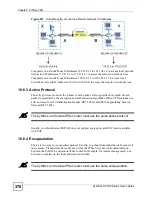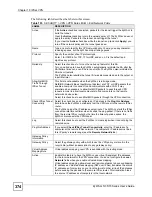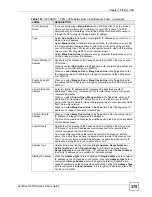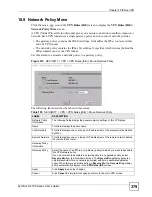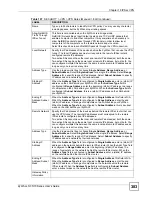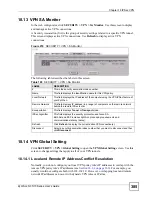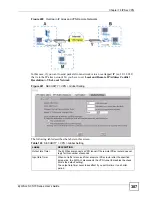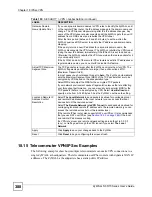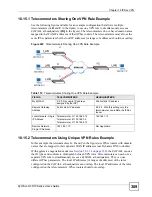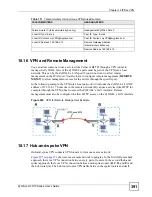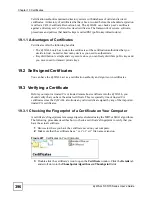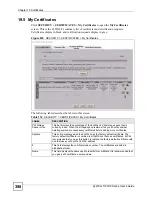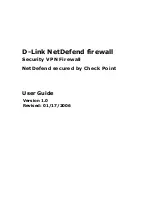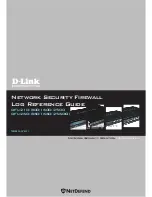
Chapter 18 IPSec VPN
ZyWALL 5/35/70 Series User’s Guide
383
Name
Type up to 32 characters to identify this VPN policy. You may use any character,
including spaces, but the ZyWALL drops trailing spaces.
Allow NetBIOS
Traffic Through
IPSec Tunnel
This field is not available when the ZyWALL is in bridge mode.
NetBIOS (Network Basic Input/Output System) are TCP or UDP packets that
enable a computer to find other computers. It may sometimes be necessary to
allow NetBIOS packets to pass through VPN tunnels in order to allow local
computers to find computers on the remote network and vice versa.
Select this check box to send NetBIOS packets through the VPN connection.
Local Network
Specify the IP addresses of the devices behind the ZyWALL that can use the VPN
tunnel. The local IP addresses must correspond to the remote IPSec router's
configured remote IP addresses.
Two active SAs cannot have the local and remote IP address(es) both the same.
Two active SAs can have the same local or remote IP address, but not both. You
can configure multiple SAs between the same local and remote IP addresses, as
long as only one is active at any time.
Address Type
Use the drop-down list box to choose
Single Address
,
Range Address
, or
Subnet Address
. Select
Single Address
for a single IP address. Select
Range
Address
for a specific range of IP addresses. Select
Subnet Address
to specify
IP addresses on a network by their subnet mask.
Starting IP
Address
When the
Address Type
field is configured to
Single Address
, enter a (static) IP
address on the LAN behind your ZyWALL. When the
Address Type
field is
configured to
Range Address
, enter the beginning (static) IP address, in a range
of computers on the LAN behind your ZyWALL. When the
Address Type
field is
configured to
Subnet Address
, this is a (static) IP address on the LAN behind
your ZyWALL.
Ending IP
Address/Subnet
Mask
When the
Address Type
field is configured to
Single Address
, this field is N/A.
When the
Address Type
field is configured to
Range Address
, enter the end
(static) IP address, in a range of computers on the LAN behind your ZyWALL.
When the
Address Type
field is configured to
Subnet Address
, this is a subnet
mask on the LAN behind your ZyWALL.
Remote Network
Specify the IP addresses of the devices behind the remote IPSec router that can
use the VPN tunnel. The remote IP addresses must correspond to the remote
IPSec router's configured local IP addresses.
Two active SAs cannot have the local and remote IP address(es) both the same.
Two active SAs can have the same local or remote IP address, but not both. You
can configure multiple SAs between the same local and remote IP addresses, as
long as only one is active at any time.
Address Type
Use the drop-down list box to choose
Single Address
,
Range Address
, or
Subnet Address
. Select
Single Address
with a single IP address. Select
Range
Address
for a specific range of IP addresses. Select
Subnet Address
to specify
IP addresses on a network by their subnet mask.
Starting IP
Address
When the
Address Type
field is configured to
Single Address
, enter a (static) IP
address on the network behind the remote IPSec router. When the Addr Type field
is configured to
Range Address
, enter the beginning (static) IP address, in a
range of computers on the network behind the remote IPSec router. When the
Address Type
field is configured to
Subnet Address
, enter a (static) IP address
on the network behind the remote IPSec router.
Ending IP
Address/Subnet
Mask
When the
Address Type
field is configured to
Single Address
, this field is N/A.
When the
Address Type
field is configured to
Range Address
, enter the end
(static) IP address, in a range of computers on the network behind the remote
IPSec router. When the
Address Type
field is configured to
Subnet Address
,
enter a subnet mask on the network behind the remote IPSec router.
Gateway Policy
Information
Table 107
SECURITY > VPN > VPN Rules (Manual) > Edit (continued)
LABEL
DESCRIPTION
Summary of Contents for ZyWALL 35 Series
Page 2: ......
Page 8: ...Safety Warnings ZyWALL 5 35 70 Series User s Guide 8 ...
Page 52: ...List of Tables ZyWALL 5 35 70 Series User s Guide 52 ...
Page 54: ...54 ...
Page 60: ...Chapter 1 Getting to Know Your ZyWALL ZyWALL 5 35 70 Series User s Guide 60 ...
Page 86: ...Chapter 2 Introducing the Web Configurator ZyWALL 5 35 70 Series User s Guide 86 ...
Page 140: ...Chapter 4 Tutorials ZyWALL 5 35 70 Series User s Guide 140 ...
Page 146: ...Chapter 5 Registration ZyWALL 5 35 70 Series User s Guide 146 ...
Page 148: ...148 ...
Page 160: ...Chapter 6 LAN Screens ZyWALL 5 35 70 Series User s Guide 160 ...
Page 173: ...Chapter 8 WAN Screens ZyWALL 5 35 70 Series User s Guide 173 Figure 93 NETWORK WAN General ...
Page 202: ...Chapter 8 WAN Screens ZyWALL 5 35 70 Series User s Guide 202 ...
Page 212: ...Chapter 9 DMZ Screens ZyWALL 5 35 70 Series User s Guide 212 ...
Page 242: ...242 ...
Page 274: ...Chapter 11 Firewall ZyWALL 5 35 70 Series User s Guide 274 ...
Page 294: ...Chapter 13 Configuring IDP ZyWALL 5 35 70 Series User s Guide 294 ...
Page 320: ...Chapter 15 Anti Spam ZyWALL 5 35 70 Series User s Guide 320 ...
Page 342: ...Chapter 16 Content Filtering Screens ZyWALL 5 35 70 Series User s Guide 342 ...
Page 350: ...Chapter 17 Content Filtering Reports ZyWALL 5 35 70 Series User s Guide 350 ...
Page 424: ...Chapter 19 Certificates ZyWALL 5 35 70 Series User s Guide 424 ...
Page 430: ...430 ...
Page 448: ...Chapter 21 Network Address Translation NAT ZyWALL 5 35 70 Series User s Guide 448 ...
Page 474: ...Chapter 24 Bandwidth Management ZyWALL 5 35 70 Series User s Guide 474 ...
Page 514: ...Chapter 26 Remote Management ZyWALL 5 35 70 Series User s Guide 514 ...
Page 533: ...533 PART V Reports Logs and Maintenance Reports 535 Logs Screens 547 Maintenance 575 ...
Page 534: ...534 ...
Page 551: ...Chapter 31 Logs Screens ZyWALL 5 35 70 Series User s Guide 551 Figure 334 LOGS Log Settings ...
Page 592: ...Chapter 32 Maintenance ZyWALL 5 35 70 Series User s Guide 592 ...
Page 594: ...594 Troubleshooting 751 Product Specifications 757 ...
Page 602: ...Chapter 33 Introducing the SMT ZyWALL 5 35 70 Series User s Guide 602 ...
Page 622: ...Chapter 35 WAN and Dial Backup Setup ZyWALL 5 35 70 Series User s Guide 622 ...
Page 628: ...Chapter 36 LAN Setup ZyWALL 5 35 70 Series User s Guide 628 ...
Page 634: ...Chapter 37 Internet Access ZyWALL 5 35 70 Series User s Guide 634 ...
Page 638: ...Chapter 38 DMZ Setup ZyWALL 5 35 70 Series User s Guide 638 ...
Page 642: ...Chapter 39 Route Setup ZyWALL 5 35 70 Series User s Guide 642 ...
Page 658: ...Chapter 41 Remote Node Setup ZyWALL 5 35 70 Series User s Guide 658 ...
Page 662: ...Chapter 42 IP Static Route Setup ZyWALL 5 35 70 Series User s Guide 662 ...
Page 700: ...Chapter 45 Filter Configuration ZyWALL 5 35 70 Series User s Guide 700 ...
Page 738: ...Chapter 50 Remote Management ZyWALL 5 35 70 Series User s Guide 738 ...
Page 746: ...Chapter 51 IP Policy Routing ZyWALL 5 35 70 Series User s Guide 746 ...
Page 766: ...766 ...
Page 770: ...Appendix A Hardware Installation ZyWALL 5 35 70 Series User s Guide 770 ...
Page 780: ...Appendix C Removing and Installing a Fuse ZyWALL 5 35 70 Series User s Guide 780 ...
Page 802: ...Appendix D Setting up Your Computer s IP Address ZyWALL 5 35 70 Series User s Guide 802 ...
Page 816: ...Appendix F Common Services ZyWALL 5 35 70 Series User s Guide 816 ...
Page 852: ...Appendix J Importing Certificates ZyWALL 5 35 70 Series User s Guide 852 ...
Page 856: ...Appendix K Legal Information ZyWALL 5 35 70 Series User s Guide 856 ...
Page 862: ...Appendix L Customer Support ZyWALL 5 35 70 Series User s Guide 862 ...


